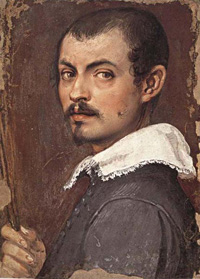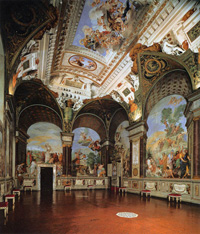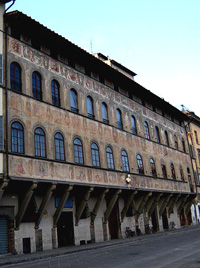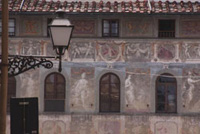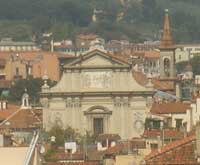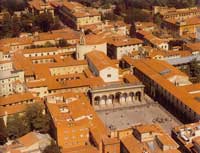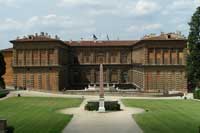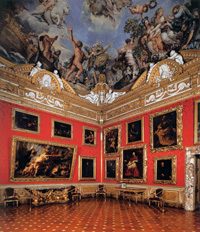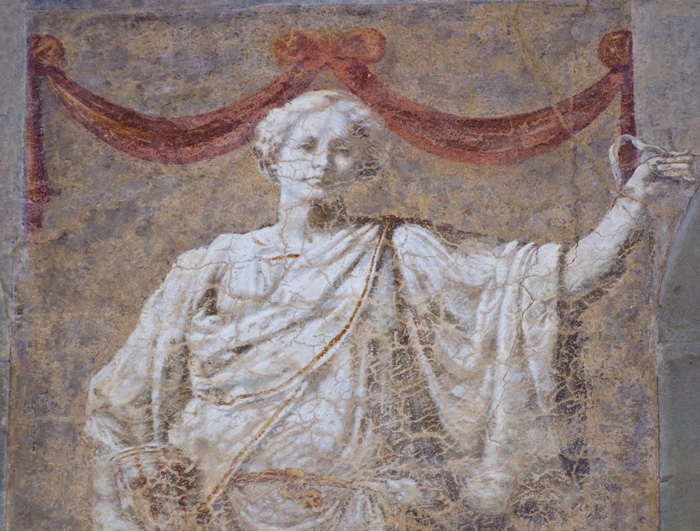 |
|
| The façade frescoes of the Palazzo dell’Antella in the Piazza Santa Croce, Florence display allegorical images with virtues and deities |
|
Giovanni da San Giovanni (Giovanni Mannozzi) |
| Giovanni da San Giovanni (Giovanni Mannozzi), Italian painter and draughtsman. He was the most distinguished of the artists working in fresco in 17th-century Florence. An eccentric personality, he was attracted by the charm and informality of northern art and by a satirical approach to classical themes. |
He went to Florence in 1608 to study in the workshop of Matteo Rosselli, where he learnt both fresco and oil painting techniques and drew extensively. |
||
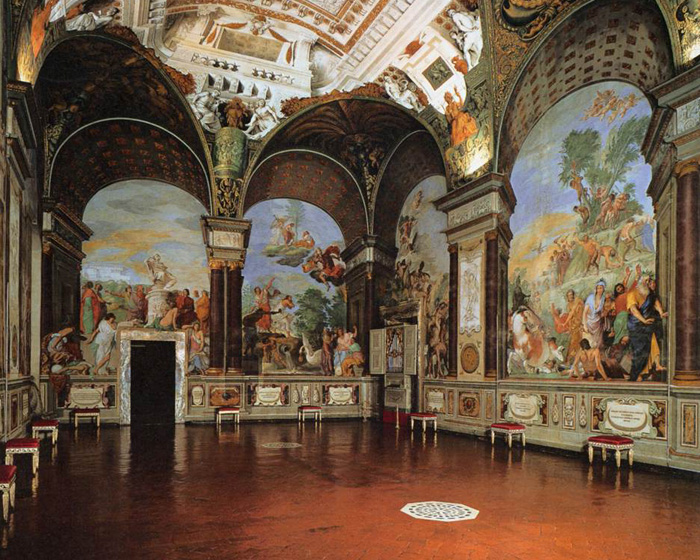 |
||
Room of Giovanni da San Giovanni, 1635, fresco, Galleria Palatina (Palazzo Pitti), Florence |
||
Giovanni da San Giovanni was commissioned in 1635 to decorate this room commonly named after him The stucco ornaments are actually painted, but evoke a sense of opulence and wealth. The particular stylistic characteristics of Giovanni da San Giovanni's painting are his extremely elegant drawing, creative fantasy, skill in organizing the scenes in a theatrical manner, fine handling of the lighter tones, and the originality of the play of light from below upwards that lend his frescoes a charm that is almost eighteenth-century. |
||
Fame Showing the Wandering Philosophers to Tuscany and Munificence |
||
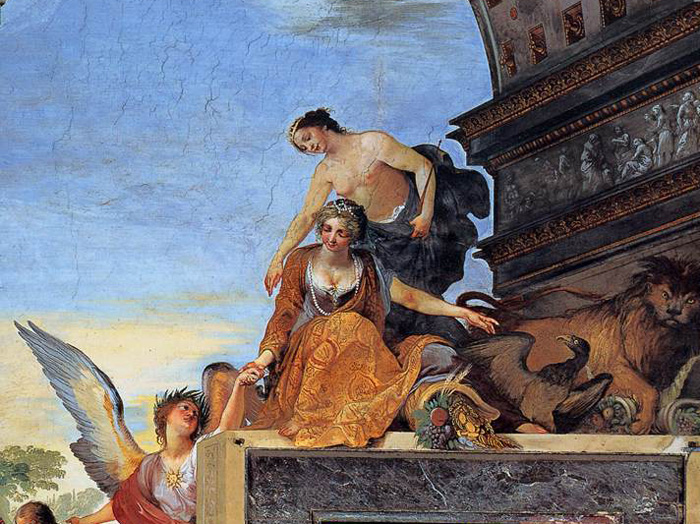 |
||
Fame Showing the Wandering Philosophers to Tuscany and Munificence, c. 1635, fresco, Galleria Palatina (Palazzo Pitti), Florence |
||
The picture shows part of the fresco decoration in the Room of Giovanni da San Giovanni.The arrivals of poets and philosophers in Tuscany after their "expulsion" from Mount Parnassus is an allusion to the fall of Constantinople into the hands of the Turks in 1453, after which Lorenzo the Magnificent offered refuge in Florence to Greek scholars who fled the Eastern capital. Recognizable are the figures of the seated Empedocles, wailing over the loss of books, as well Aristotle and Plato. The seminude allegory of Tuscany standing behind Munificence receives the wanderers who are being recommended to her by winged Fame. |
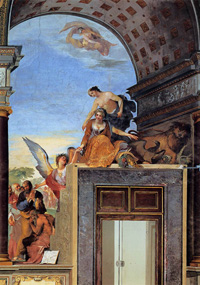 Fame Showing the Wandering Philosophers to Tuscany and Munificence, c. 1635, fresco, Galleria Palatina (Palazzo Pitti), Florence
|
|
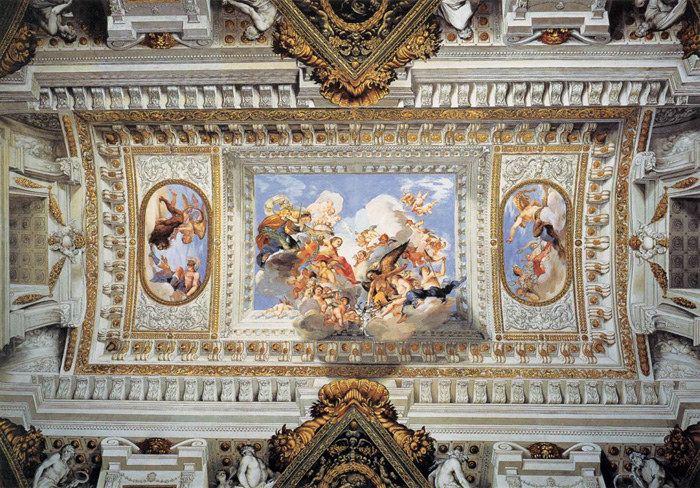 |
||
Allegory of the Marriage of Vittoria della Rovere with Ferdinando II de' Medici, 1637, fresco, Galleria Palatina (Palazzo Pitti), Florence |
||
The picture shows the ceiling fresco in the Room of Giovanni da San Giovanni. In 1637, Ferdinando II de' Medici, Grand Duke of Tuscany, married Vittoria della Rovere, last heir of the Dukes of Urbino, whose extraordinary dowry of art objects enormously enriched the already conspicuous outstanding Medici collections.
|
||
|
||
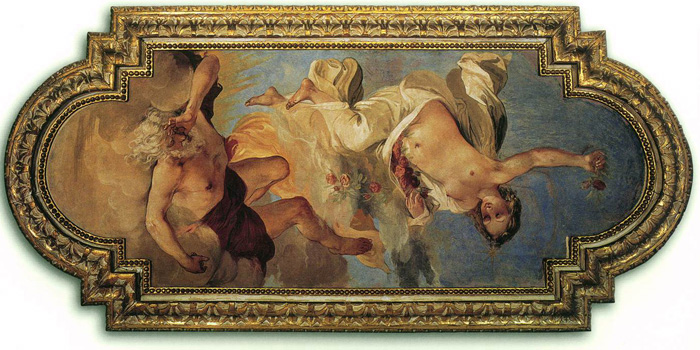 |
||
Giovanni da San Giovanni, Aurora and Tithonus, 1634-35, detached fresco, 360 x 160 cm, Museo Bardini, Florence |
||
Aurora was the sister of Helios, the sun-god. Every morning she rose from her bed leaving her aged husband Tithonus still sleeping, and led Helios into the heavens. She was a popular figure in seventeenth-century Baroque ceiling painting. Giovanni da San Giovanni's painting was originally at centre ceiling of a room in Pucci Palace in Florence, as can be seen from the much foreshortened figure of Tithonus. |
||
| [1] Matteo Rosselli was an influential artist of the early 17th century in Florence, he is described by the early sources as being of a gentle disposition and as a dedicated and dignified painter, although he lacked originality and power. His work is characterized by the simplicity, descriptive naturalism and refined colour of the Counter-Reformation art created by such Tuscan artists as Santi di Tito, Bernardino Poccetti, Lodovico Cigoli and Domenico Passignano, yet he was also responsive to Venetian and Emilian art. The son of Alfonso Rosselli and Elena Coppi, he received his early education in Gregorio Pagani's studio, which he attended from as early as 1587. His initial inclination was towards classical and balanced compositions, in which the influence of Andrea del Sarto, whose frescoes he copied in the Chiostro dello Scalzo, is clear. On 26 February 1599 he was admitted to the Accademia del Disegno and in 1605 went to be with Passignano in Rome for six months, greatly enriching his artistic experiences through this contact. He returned to Florence in the same year and, on Pagani's death (1605), completed his master's unfinished works with great success. Pagani's influence can be seen in the bright colours of Rosselli's Adoration of the Magi (1607; Montevarchi, Arezzo, S Andrea). To 1610 belong two monochrome paintings depicting Henry IV at Nantes and Henry IV at Gaudebec (Florence, Pitti, repository), executed for the funerary ceremonies that took place in S Lorenzo on the death of the French sovereign. Rosselli's interest in fluent, fresh and richly anecdotal narrative, indebted to Poccetti, is already evident in these works. In his Crucifixion (1613; Scarperia, Prepositurale), still within a Florentine tradition, there is a more varied chiaroscuro and a more expressive and softer handling, which suggests a response to Coreggio, whose art he probably knew through Pagani. His interest in anecdote found its full expression in the lunettes (1614-18) depicting scenes from the lives of the founders of the Servite Order in the Chiostro dei Morti of the church of the Annunziata, Florence, and is also demonstrated, in combination with the brilliant colour of his earlier paintings, inspired by Lodovico Cigoli, in his Last Supper (1614; Florence, Conservatorio di S Pier Martire). To 1615 belongs the painting of the Fortifications of San Miniato, the first of three scenes (the others were completed in 1627 and 1628) drawn from the life of Michelangelo whose nephew, Michelangelo Buonarroti the younger, commissioned them for the Casa Buonarroti, Florence. Here the rhetorical gestures are softened by the realism of the facial expressions and by the landscape, which is enriched by lively figures in the background. From 1619 Rosselli won the patronage of such important families as the Medici, the Corsini and the Dragomanni, and his activity increased. For the reception rooms of the villa at Poggio Imperiale he executed frescoes portraying the emperors Charles V, Frederick II and Maximilian I as well as biblical and historical heroines, datable to between 1619 and 1623. He took part in the frescoed decoration (1620) of the façade of the Palazzo dei dell'Antella in Piazza Santa Croce, Florence, and in 1621 won the commission for the Triumph of David (Florence, Pitti) and for the pair of paintings depicting Lot and his Daughters and Tobias and the Angel (1621; Florence, Galleria Corsini). The Triumph of David is a successful work, with skilled chiaroscuro and a disciplined yet intense atmosphere; the latter two works are characterized by more idealized figures, more classical compositions, and a greater delicacy of handling. These qualities distinguish this period of the artist's work. Further decorations (1622-3) were commissioned by Leopoldo de' Medici for the Casino di S Marco; these works, rich in echoes of Venetian art, depict the Rebuilding of the Port of Livorno by Frederick II and the Capture of Ippona (Florence, Corte d'Assise). Leopoldo also commissioned from Rosselli the allegorical paintings (1622) in the Sala della Stufa in Palazzo Pitti. |
|
|||
|
||||
|
This article incorporates material from the Wikipedia article Giovanni da San Giovanni published under the GNU Free Documentation License. |
||||
|
||||
 |
||||
Podere Santa Pia overlooks the beautiful Tuscan valley where the vineyards thrive. Although this is off the beaten track it is the ideal choice for those seeking a peaceful, uncontaminated environment. |
||||
The façade and the bell tower of
|
Piazza della Santissima Annunziata in Florence |
Florence, Duomo |
||
Palazzo Pitti, which houses several important museums, was built in the second half of the 15th century probably on a project of Filippo Brunclleschi for Luca Pitti, but was unfinished at his death in 1472. The original building, formed by two floors and the ground floors, with only live windows on each floor, was purchased in 1550 by Eleonora da Toledo, the wife of the Grand Duke Cosimo I de` Medici, thus becoming the official residence of the family. For this reason it was widened and changed, in 1560 by Bartolomeo Ammannati and at the beginning of the 17th century by Giulio and Alfonso Parigi. The latter two architects gave the facade its present day aspect, with the only exception of the two lateral projecting pavilions that were built in the age of the Lorraine family and completed during the first half of the l9th century by Paoletti and Poccianti, who also built the Palazzina della Meridiana, added on to the rear section of the palace overlooking the garden. |
||||
| Museum Bardini The museum is situated in a fine building refurbished by Stefano Bardini at the end of the 18th century and donated by its owner to the Municipal Administration of Florence in 1922. Bardim was a famous art dealer who collected objects of different periods and of high quality. Even the building itself is remarkable for its use of doors, windows and mouldings of old fragments originally belonging to ruined churches and villas. The ceilings are magnificent examples of Venetian and Tuscan woodwork ranging from the 15th to the 17th centuries. The collection comprises sculptures, paintings, furniture pieces, ceramic pieces, tapestries but also fragments of the old centre of Florence salvaged before its destruction. All these items are displayed on the ground and the first floors according to a layout that fully reflects the character of a typically private collection, with the touch of a rather suggestive setting. In addition to Roman sarcophagi, capitals, Roman and Gothic relief work, there are also other remarkable examples like the -work of the Delia Robbia brothers (15th and 16th century), works attributed to Donatello and to Nino or Giovanni Pisano, in addition to the famous Charity by Tino di Camaino (1280 app.-1337). The most outstanding painting of the collection is perhaps St. Michael Archangel by Antonio Del Pollaiolo (1431-1498), although there are many other precious works among the collections of weapons, 15th century polychrome stuccoes and wooden sculpture. The collection of old musical instruments is also worth a visit. The second floor of the building exhibits the Corsi collection that comprises some `works from the 12th to the 19th centuries, donated by Mrs. Carobbi, the widow of Corsi, in 1938 ..... from `Museums and Galleries of Florence and surroundings` ( Apt - Florence ) Museum Bardini, Piazza de`Mozzi, 1 Gardens in Tuscany | The Bardini Garden in Florence Walking in Tuscany | Florence | San Niccolo Neighbourhood in Oltrarno |
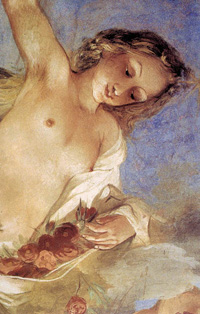 Giovanni da San Giovanni, Aurora and Tithonus (detail), 1634-35, detached fresco, 360 x 160 cm, Museo Bardini, Florence |
|||

